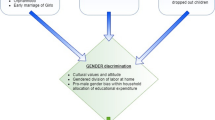Abstract
This paper explores out-of-school suspensions and expulsions among Black females, who have often been ignored in the extant educational research literature. More specifically, the authors explore the question of whether Black females have been overrepresented in out-of-school suspensions and expulsions in New Jersey public schools. Using data from the Civil Rights Data Collection (CRDC), the authors found that Black females in New Jersey have in fact been overrepresented in both, out-of-school suspensions and expulsions. The extent of that overrepresentation of Black females has not only worsened over time but could also be considered graver in New Jersey than in the rest of the United States. The authors additionally contend that these school push-outs increase the likelihood that Black girls will enter the school-to-criminal justice pipeline. After discussing the study findings in detail, the authors provide several recommendations that are designed to help better comprehend and address the various discipline-related issues impacting Black girls in the New Jersey public school system and that could potentially have broader implications for all of the nation’s schools.
Similar content being viewed by others
References
Blake, J., Butler, B., Lewis, C., & Darensbourg, A. (2011). Unmasking the inequitable discipline experiences of urban black girls: implications for urban educational stakeholders. The Urban Review, 43, 90–106.
Center for Community College Student Engagement. (2014). Comprehensive fact sheet: Men of color in higher education. Retrieved on September 25, 2018 from https://files.eric.ed.gov/fulltext/ED561195.pdf.
Cornell, D., & Lovegrove, P. (2015). Student threat assessment as a method of reducing school suspensions. In D. J. Losen (Ed.), Closing the school discipline gap: Equitable remedies for excessive exclusion. New York: Teachers College Press.
Epstein, R., Blake, J. J., & Gonzalez, T. (2017). Girlhood interrupted: The erasure of Black girls’ childhood. Washington, DC: Center of Poverty and Inequality, Georgetown Law.
Gonzalez, T. (2015). Socializing schools: Addressing racial disparities in discipline through restorative justice. In D. J. Losen (Ed.), Closing the school discipline gap: Equitable remedies for excessive exclusion. New York: Teachers College Press.
Guerra, M. (2013, November 7). Fact sheet: The state of African American women in the United States. Retrieved on September 25, 2018 from https://www.americanprogress.org/issues/race/reports/2013/11/07/79165/fact-sheet-the-state-of-african-american-women-in-the-united-states/.
Harper, C. (2018, May 14). HCBUs, BLACK women and STEM success. Higher education today. Retrieved on September 25, 2018 from https://www.higheredtoday.org/2018/05/14/hbcus-black-women-stem-success/.
Hu, W. (2011, August 30). Bullying law puts New Jersey schools on the spot, NY Times. Retrieved from http://www.nytimes.com/2011/08/30/nyregion/bullying-law-puts-new-jersey-schools-on-spot.html?pagewanted=all.
Jewell, K. S. (1993). From Mammy to Miss America and beyond: Cultural images and the shaping of US social policy. London and New York: Routledge.
Losen, D. (2015). Conclusion. In D. J. Losen (Ed.), Closing the school discipline gap: Equitable remedies for excessive exclusion. New York: Teachers College Press.
Morris, E. (2007). “Ladies” or “Loudies”? Perceptions and experiences of Black girls in classrooms. Youth & Society, 20(10), 1–26.
Morris, M. (2016, November). Protecting black girls. Educational leadership. Alexandria, VA: Association of Supervision and Curriculum Development.
Morris, E., & Perry, B. (2017). Girls behaving badly? Race, gender, and subjective evaluation in the discipline of African American girls. Sociology of Education, 90(2), 127–148.
Osher, D. M., Poirier, J. M., Jarjoura, G. R., & Brown, R. (2015). Avoid quick fixes: Lessons learned from a comprehensive districtwide approach to improve conditions for learning. In D. J. Losen (Ed.), Closing the school discipline gap: Equitable remedies for excessive exclusion (pp. 192–206). New York: Teachers College Press.
Patterson, O. (1998). Rituals of blood: Consequences of slavery in two American centuries. New York: Basic Books.
Paul, D. G. (2003). Talkin’ back: Raising and educating resilient Black girls. Westport, CT: Praeger Press.
Petras, H., Masyn, K. E., Buckley, J. A., Ialongo, N. S., & Kellam, S. (2011). Who is most at risk for school removal? A multilevel discrete-time survival analysis of individual- and context-level influences. Journal of Educational Psychology, 103(1), 223–237.
Raffaele Mendez, L. M., & Knoff, H. M. (2003). Who gets suspended from school and why: A demographic analysis of schools and disciplinary infractions in a large school district. Education and Treatment of Children, 26, 30–51.
United States Department of Education: Civil Rights Data Collection. (2000). 2000 New Jersey estimations [Data File]. Retrieved from http://ocrdata.ed.gov/StateNationalEstimations/Projections_2000.
United States Department of Education: Civil Rights Data Collection. (2012). 2011–2012 discipline estimations for New Jersey [Data File]. Retrieved from http://ocrdata.ed.gov/StateNationalEstimations/Estimations_2011_12.
United States Department of Education: Civil Rights Data Collection. (2012). 2011–2012 estimations for enrollment [Data File]. Retrieved from http://ocrdata.ed.gov/StateNationalEstimations/Estimations_2011_12.
United States Department of Education: Office for Civil Rights (2014). Civil rights data collection data snapshot: School discipline. Retrieved from https://ocrdata.ed.gov/downloads/crdc-school-discipline-snapshot.pdf.
Vandehaar, J. E., Petrosko, J. M., & Munoz, M. A. (2015). Reconsidering the alternatives: The relationship among suspension, placement, subsequent juvenile detention, and the salience of race. In D. J. Losen (Ed.), Closing the school discipline gap: Equitable remedies for excessive exclusion (pp. 222–236). New York: Teachers College Press.
Wallace, J. M., Goodkind, S., Wallace, C. M., & Bachman, J. G. (2008). Racial, ethnic, and gender differences in school discipline among U.S. high school students: 1991–2005. The Negro Educational Review, 59(1–2), 47–62.
Author information
Authors and Affiliations
Corresponding author
Rights and permissions
About this article
Cite this article
Paul, D.G., Araneo, J. “Orange is the New Black” Comes to New Jersey’s Public Schools: Black Girls and Disproportionate Rates of Out-of-School Suspensions and Expulsions. Urban Rev 51, 326–343 (2019). https://doi.org/10.1007/s11256-018-0483-8
Published:
Issue Date:
DOI: https://doi.org/10.1007/s11256-018-0483-8




